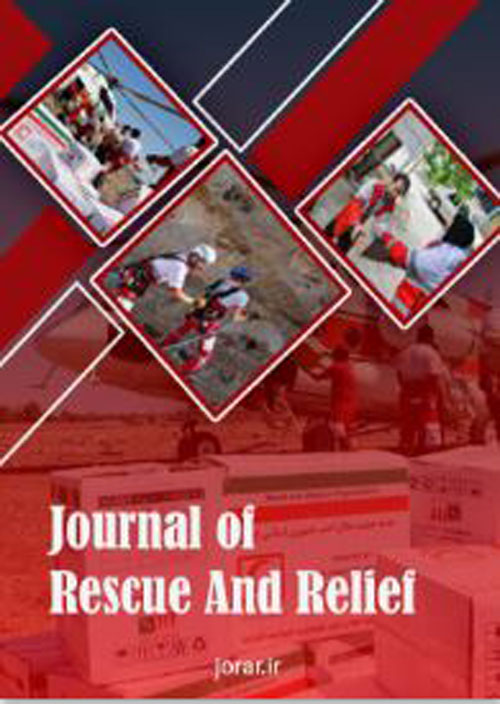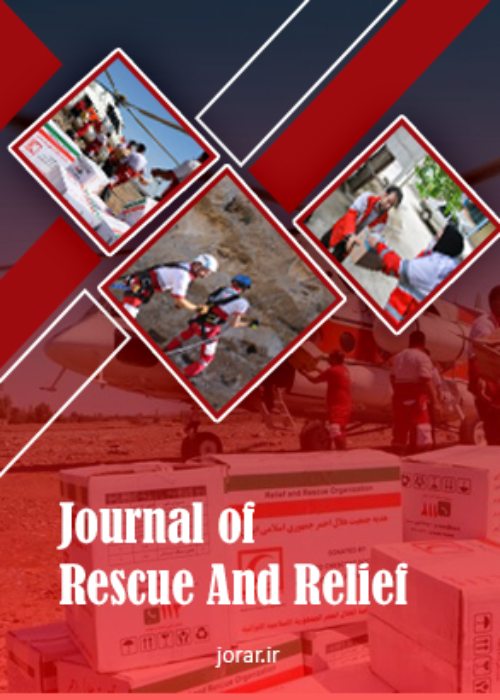فهرست مطالب

Scientific Journal of Rescue Relief
Volume:14 Issue: 3, Autumn 2022
- تاریخ انتشار: 1401/06/29
- تعداد عناوین: 6
-
-
Pages 156-162INTRODUCTION
Iran, especially the Sistan-Baluchestan province, is one of the countries with the highest rates of accidents and traffic-related deaths. The present study aimed to evaluate traffic accidents referred to hospitals and the Forensic Medicine Department in Nikshahr in Sistan-Baluchestan province, Iran, during 2014-2018.
METHODSIn this retrospective descriptive and analytical study, the statistical population included traffic accidents referred to hospitals and the Department of Forensic Medicine in Nikshahr. The data related to the variables of age, gender, location of the accident (inside or outside urban areas, rural roads), condition of the injured, severity of the injury, and the time of the accident were collected using a checklist. After determining the descriptive statistical indicators, the incidents were analyzed using chi-square and correlation tests.
FINDINGSDuring the study years in Nikshahr, a total of 3,669 people were involved in road accidents, out of whom 339 cases lost their lives. The highest rate of accidents (36%; n=1321) was in the age group of 19-29 years. Regarding education, 3, 260 (88.8%) crash victims were illiterate and without a university degree, while 409 (11.15%) cases had academic education. It was also detected that 1,879 (51.2%) accident victims were motorcycle riders with reported fractures, severe injuries, head injuries, and death.
CONCLUSIONThe results of the current pointed to the high rate of traffic-related deaths in Nikshahr, especially in summer. Therefore, prevention management is necessary to reduce traffic accidents and fatalities.
Keywords: Epidemiology, Traffic Accidents, Mortality, Nikshahr, injuries -
Pages 163-175INTRODUCTION
This research aimed to provide a dynamic model of organizational citizenship behavior (OCB) in crisis management non-governmental organizations with a social approach (experimental evidence: Red Crescent Society of the Islamic Republic of Iran).
METHODSThis applied research was conducted using a mixed (quantitative-qualitative) method to analyze the data. The statistical population consisted of university professors as well as the managers and experts of the Iranian Red Crescent Society, who were selected by the snowball sampling method. The total number of experts in the Iranian Red Crescent Society and in the academic community accounted for 10 individuals (n=5 each), and the sampling continued until reaching theoretical saturation. The required information was collected through observation, in-depth and semi-in-depth interviews, review of documents, and experts' opinions; finally, by using the exploratory factor analytical statistical method, appropriate measurement tools were prepared. In this research, the Delphi technique and the Decision-Making Trial and Evaluation Laboratory-based Analytic Network Process were employed to determine and prioritize criteria and sub-criteria. For this purpose, the pairwise comparison matrix was used to determine the weight of the criteria.
FINDINGSIn this study, helping behaviors, individual initiatives, organizational obedience, organizational loyalty, chivalry, civic virtue, and personal development were among the dimensions of OCB in descending order.
CONCLUSIONThe results of this research showed that the consequences of OCB included an increase in performance productivity and effectiveness, the promotion of positive relations between employees, more efficiency in allocating resources, reduction in maintenance costs, the provision of necessary flexibility for innovation, improvement of customer service, and effective use of scarce resources.
Keywords: Organizational Citizenship Behavior, NGO, Crisis Management, Red Crescent Society -
Pages 192-210INTRODUCTION
The present study aimed to investigate communication, information exchange, cooperation, and trust networks in Iran's Humanitarian Supply Chain at both inter-organizational and interpersonal levels.
METHODSThis applied research was conducted based on a descriptive survey design. The statistical population of this research included the organizations and people involved in relief operations performed in three recent disasters: the fire-induced collapse of the Plasco building, Shahran gas explosion, and the flash flood in the Tehran subway. In order to analyze networks, a questionnaire containing network analysis questions was designed. Upon the completion of the questionnaires, the data of each network were entered systematically into a matrix on an excel spreadsheet. Such indexes as degree centrality, betweenness centrality, intersection points, isolation points, and network density were calculated by Ucinet and NetDraw software packages; therefore, the networks were analyzed.
FINDINGSBased on the results obtained from the analysis of communication, information exchange, and cooperation networks, the network density was 21%, indicating a low level of organizational relationship. At this level of communication, information exchange and cooperation were obtained at 11.5% and 16.5%, respectively. The analysis of the trust network also illustrated that the density of this network was 26.6%, suggesting that out of 21% of connections, there was about a quarter of possible trust. This is suggestive of low levels of inter-organizational Trust.
CONCLUSIONBuilding trust in Iran's humanitarian service supply chain can be very effective in the acceleration of service supply, organization, and success of relief operations
Keywords: Humanitarian Services, Network Analysis, Supply Chain, Trust -
Pages 211-221INTRODUCTION
The Red Crescent Society of the Islamic Republic of Iran is one of the most effective service-oriented organizations in the country which has a high potential for trust building and role modelling. Using human resources with a humanitarian approach and identification of causal, contextual, and intervening factors that lead to building trust contribute to the excellence of this popular institution. Therefore, this study aimed to present a model of organizational trust based on the assumptions of human resources in service-oriented organizations, particularly The Red Crescent Society of the Islamic Republic of Iran, using the meta-synthesis approach.
METHODSThis is a qualitative cross-sectional study, in which 1,269 relevant articles published between 2010 and 2022 were collected from the Web of Science database. A total of 85 articles were selected and used, as the basis for the data extraction, to determine trust building based on the assumptions of human resources theories in the interpretive paradigm.
FINDINGSTrust building in the Red Crescent population is one of its essential elements due to the impact of environmental and human variables. Therefore, this study identified causal conditions (organizational factors, job, employees), background conditions (culture, ethics, religion, individual, organization, intervening conditions (managerial, occupational, and psychological), strategies (new leadership, transparency, Quantum management, talent management), and the outcomes (including organizational citizenship behaviour, social responsibility, organizational spirituality), which included a total of 28 common features and 152 components.
CONCLUSIONBased on the obtained results, trust-building management methods in the Red Crescent Society include open communication, brainstorming, collaborative management, a supportive atmosphere, and effective strategies in the functional dimensions of the Red Crescent Society, including new leadership, behavioural assumptions of managers, as well as decision-making in terms of content, time, model, cognition, and approaches of transformative leadership, ethical and pure leadership, positive and servant leadership, and distributed and intellectual leadership.
Keywords: Human Resource Assumptions, Organizational Trust, Service-oriented Organizations, Red Crescent Society -
Pages 222-230INTRODUCTION
Behavioural patterns of the people can affect the emergency evacuation procedure. The most important issue of crisis management is to evacuate the people from the accident site in the shortest time and with the maximum speed. Pilgrimage destinations attract many pilgrims on religious occasions, and this has highlighted the importance of addressing this issue in these centers. This study aimed to explain and propose an optimal evacuation exit plan for pilgrims during accidents in the most important and prominent religious center of Iran (Holy Shrine of Imam Reza).
METHODSThis descriptive-analytical study was performed using an applied research method. The document-library and field methods were used to collect data. The statistical population includes the managers of the Holy Shrine complex, experts of the crisis management headquarters, consulting engineers in architecture and urban planning, as well as managers and experts in Mashhad Municipality. The sample size was estimated to be 384 cases based on Cochran's formula. The collected data via questionnaires were analyzed by SPSS and Smart PLS software using structural equation modelling.
FINDINGSAccording to the results, the presented model includes seven variables (group movement, individual movement, incident management technology tools, perception of the physical environment, physical movement, modelling, and behavioural culture) affecting the pilgrims leaving the incident site in the Holy Shrine of Imam Reza.
CONCLUSIONThe results of this study indicated that the presented model with 7 variables and 21 parameters can be used as a suitable model in other places.
Keywords: Crisis Management, Emergency Evacuation, Holy Shrine of Imam Reza (AS), Optimal Model


